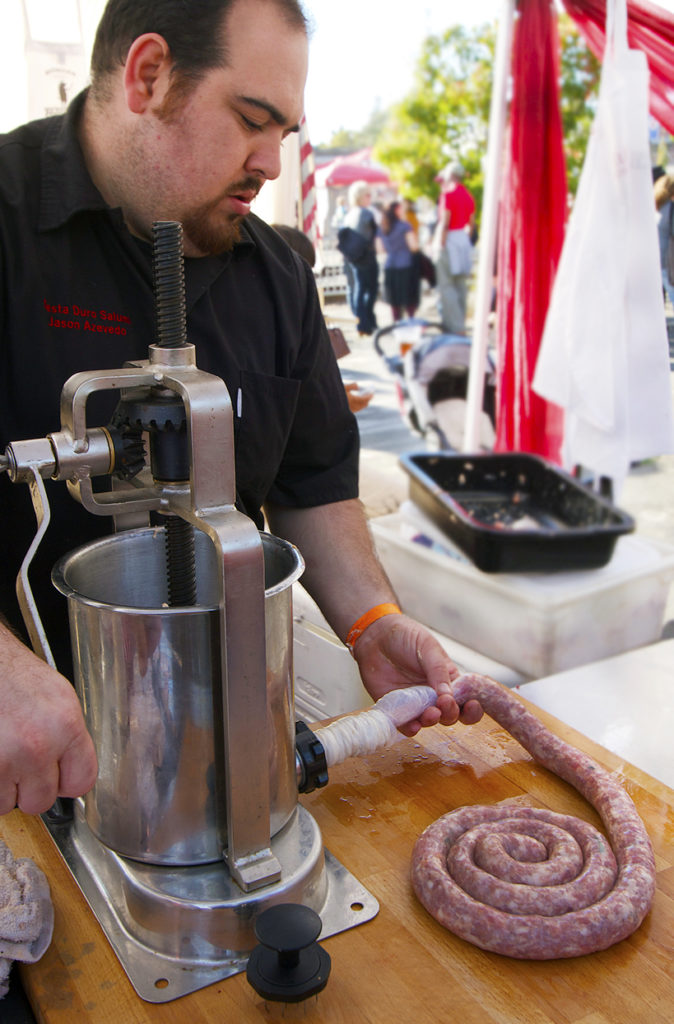 (THIS IS AN EDITED VERSION THAT APPEARED IN THE PRESS DEMOCRAT. If you prefer to read an unedited version that I will warn you in advance contains graphic images of the event, CLICK HERE and ENTER THE PASSWORD: reggiebacon.)
(THIS IS AN EDITED VERSION THAT APPEARED IN THE PRESS DEMOCRAT. If you prefer to read an unedited version that I will warn you in advance contains graphic images of the event, CLICK HERE and ENTER THE PASSWORD: reggiebacon.)
Hesitation has no place at the slaughter. The kill must be quick, the hand swift and the mind resolved.
Nervously lifting my condemned pig off the back of Sonoma rancher Nancy Prebilich’s pickup truck, I feel none of these things. The 50-pound black and white Hampshire prances and sniffs from inside the metal cage, unaware that the handful of clover we’ve tossed inside will be his last meal.
“Do you want to do it?” asks Prebilich, pointing to a .22 rifle. She knows I’m ambivalent. Firearms aren’t in my repertoire, and we agreed earlier it wouldn’t be fair to the animal should my aim and inexperience falter. I’m sure the wan look on my face confirms the choice. But it feels like a failure on my part not to do the deed I’d promised to do six weeks ago, when this adventure began.
In August, I purchased a piglet from Gleason Ranch with plans to raise, kill and eat it. The idea was simply to get to know my meat, to break down the walls most carnivores prefer never to look behind. But the process isn’t without peril. Few ranchers are willing to publicly open their barn doors to the process of harvesting animals, and even fewer of us really want to know that our bacon had a face.
Learning of my intentions, several local vegans vocally pleaded for the life of my first pig (which we’d named Reggie Bacon), ultimately securing my consent and the resources to send him to a no-kill farm sanctuary in Orland. Their compassionate perspective on meat-eating became an integral part of the story, strengthening my resolve as a carnivore to stop taking my pork chops for granted.
So, in late September, another pig from Reggie Bacon’s litter was purchased without chance of reprieve. After wrestling the squirming, muscular creature into a cage and driving through rural West County to a backyard processing facility, his moment had finally arrived. Heart racing, I feel queasy and unsure about the inevitable process about to unfold.
Yet there is no place for my hesitation here, and the trigger is pulled. With a ping that sounded more like a BB gun than a rifle, the bullet hits its mark. The pig’s legs instantly buckle and it collapses; brain function has ceased. We’ve called upon a more seasoned butcher at the facility to grab the animal from its cage and quickly cut the jugular vein. He has the deft sureness of a butcher who knows every inch of the animal’s anatomy.
Kneeling, he makes a single cut and blood pumps from the neck, a necessary step to keep the meat from spoiling. As it blooms onto the wet concrete, my hand instinctively lifts to cover my mouth, my eyes widen. The animal continues to have jolting, reflexive movements for several minutes. I won’t pretend it isn’t shocking to watch. I am grateful when it is over.
The carcass is lowered into heated water so the hair can be removed, then the internal organs are removed delicately. Handling the pig is intensely intimate; I am aware that this is no pork chop, but an animal that minutes ago was alive.
We constantly spray the carcass with water to keep eager flies away. This is hot, messy and difficult work. It is easy to see why efficient and sanitary facilities are necessary for commercial meat processing and appreciate the strength of our ancestors, for whom this was a frequent task.
Though the pig is for personal consumption (hence why we’re not at a USDA-regulated facility required for commercial processing), we hurry to get the carcass on ice, placing it into an ice chest with a chicken and rabbit that we’ve also harvested.
Several days later, all of the animals are broken down into smaller pieces at a butchering demonstration at Santa Rosa’s Great Handcar Regatta September 25. A crowd gathers to watch as chefs wield huge knives, dissecting the animals into more familiar dinner-sized pieces. Here is a loin, ribs, a leg for ham. Faces range from enraptured to disgusted. That is exactly the point. Our audience is getting personal with their food as well.
A heavy plastic tub holds the remaining pieces, and our pig becomes a communal feast. The cheeks and ears are wrapped around the belly to create a porchetta di testa; the legs will be smoked to become hams. Shoulders are brined and slow-cooked.
A chef friend boils the head to make a gelatinous head cheese, and the ribs somehow disappear after the event, no doubt ending up on someone’s grill. Nothing is wasted, nothing pushed aside uneaten.
But this pig is not an easy meal for me. With every bite, I’m reminded of the process. The meat is leaner, rougher, a hint gamier. It’s not perfect, but as I chew, I am again grateful. I can say without hesitation that I’ve gotten personal with my dinner, looked it straight in the eye and taken part in bringing it to the table.
Missed the first two chapters of this story?
Chapter 1: Meet your Meat
Chapter 2: A Reprieve for Reggie










